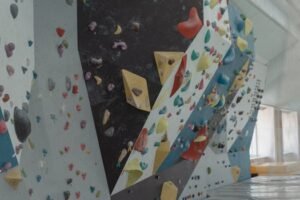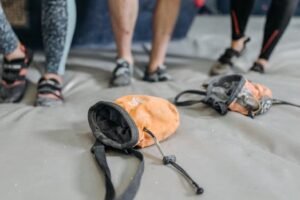The Best Climbing Training Plan
Do you really want to level up your climbing game? If you’re passionate about scaling new heights—literally—then having a smart and sustainable climbing training plan is absolutely key. Too often, climbers fall into the trap of thinking that more is better. But if you want to truly improve without burning out or getting injured, you’ll need to follow a few core principles about what to do—and more importantly, what not to do.
Table of Contents
ToggleHere are five essential tips to guide your climbing journey, whether you’re a complete beginner or already crushing hard routes. Let’s dive in.
1. Avoid Overtraining at All Costs
We get it—climbing is addictive. Once you start making progress, it’s easy to want to spend every free moment at the gym or crag. But here’s the thing: overtraining doesn’t just plateau your progress, it kills it. Even worse, it massively increases your chances of injury, especially in the tendons and joints, which are notoriously slow to heal.
A smarter climbing training approach is to match your schedule to your experience level:
Beginners: No more than twice a week. Give your body the time it needs to adapt and recover.
Intermediate climbers: Stick to three sessions a week, spaced out to avoid back-to-back days.
Advanced climbers: Try the 2-1-2-2 method – two days climbing, one day rest, two more days climbing, then two days rest. Your hardest project attempts should be planned for the first session after your two-day rest when your body is freshest and strongest. At this stage you can start introducing climbing boards.
 TWO STONES Climbing Hangboard Rock for Best Climbing Training Plan
TWO STONES Climbing Hangboard Rock for Best Climbing Training Plan
If you're serious about improving your climbing strength and grip, this Hangboard Fingerboard Training Board might be part of the best climbing training plan for your setup. Made from high-quality wood, it's skin-friendly and kind on your fingers, even during tough sessions. With multiple grip positions—including crimps, slopers, and pockets—this board lets you target key muscle groups and push your limits gradually. It’s compact, easy to mount, and ideal for home workouts when you can't make it to the wall.
- Smooth wooden texture is gentle on skin
- Versatile grip options for progressive training
- Great for small home setups
- May not suit absolute beginners without fingerboard experience
2. Beginners: Prioritize Technique Over Strength
If you’re just starting out, it can be tempting to chase those pull-up numbers or hit the hangboard early. Don’t. At this stage, strength isn’t what’s holding you back—technique is.
Focusing on clean footwork, body positioning, balance, and reading routes will benefit you much more than doing a few extra pull-ups. When you don’t rely on brute strength, you’re forced to find better, more efficient ways to climb. That kind of movement intelligence will serve you for years to come.
Use your climbing sessions to experiment with technique: try silent feet, controlled movements, and smooth transitions. You’ll not only climb better, but you’ll also build a solid base for when it is time to train strength.
3. Advanced Climbers: Strength Work Comes First
If you’re already climbing at a higher level, you know that technique alone won’t get you up the hardest routes. That’s where strength comes into play. But timing is everything.
Do strength training at the beginning of your sessions, when your muscles are fresh and your nervous system is fully alert. This is the best time to use the hangboard to build finger strength—one of the most important assets for any advanced climber.
A great protocol to follow after warming up of course:
Hang with body weight on small edges for 10 seconds
Rest for at least 3 minutes
Repeat 2–3 sets of 6 hangs total
It might feel like you’re spending more time resting than training, but trust the process. These long rests allow you to exert maximum force in each hang, which is how you build true strength without over-fatiguing your muscles.
 La Sportiva Miura Lime Unisex Children's Climbing Shoes
La Sportiva Miura Lime Unisex Children's Climbing Shoes
The La Sportiva Miura Climbing Shoes are a legendary choice for climbers who want precision, power, and reliability—perfect if you're following the best climbing training plan and need gear that keeps up. With an aggressive downturn and a precise toe box, these shoes are built for technical edging, steep sport climbs, and overhangs. The Vibram XS Edge rubber grips on just about anything, and the lacing system ensures a snug, customized fit. Trusted by pros for decades, the Miura is a high-performance shoe that thrives on vertical terrain.
- Excellent edging and toe precision
- Durable Vibram XS Edge rubber
- Secure, adjustable lace-up fit
- Takes time to break in comfortably
4. Eat Enough Protein (Seriously)
Nutrition is the often-overlooked pillar of any good climbing training plan. Specifically: protein. Your muscles don’t grow stronger just because you train them. They grow during recovery—and that requires building blocks, a.k.a. protein.
Make sure you’re hitting your daily protein goal based on your body weight and activity level. If you’re unsure what that looks like, check out my other post on the best supplements for climbing where I break it down. But the bottom line is: no protein, no muscle growth—no strength gains either.
 Optimum Nutrition Gold Standard Whey Protein Powder Muscle Building
Optimum Nutrition Gold Standard Whey Protein Powder Muscle Building
The Optimum Nutrition Gold Standard Whey Protein is a go-to supplement for athletes, climbers, and anyone following the best climbing training plan who wants to recover faster and build lean muscle. With 24g of high-quality whey protein per serving, plus naturally occurring BCAAs and glutamine, it supports muscle repair after intense sessions. It mixes easily, tastes great, and helps you stay fueled whether you're training at the gym or hitting the wall hard.
- 24g protein with BCAAs and glutamine per serving
- Fast absorption for effective post-workout recovery
- Wide range of tasty, mixable flavors
- Contains some artificial sweeteners
5. Listen to Your Body (It’s Smarter Than You Think)
Lastly, and perhaps most importantly: pay attention to the signs your body is giving you. If you feel joint pain, sharp twinges, or deep fatigue—stop. Climbing through pain is a guaranteed way to land yourself in a months-long injury timeout.
The best climbing training plan isn’t about how much you can cram into a week, it’s about consistent, smart effort over time. Sometimes, climbing less leads to better performance because your body is fresh, your mind is focused, and your stoke is high.
Final Thoughts
If you’re committed to becoming a better climber, don’t just wing it. Follow a structured, balanced, and personalized best climbing training plan that evolves with you. Respect your limits, train with intention, and remember—progress in climbing is a marathon, not a sprint.
Start slow, stay smart, and climb strong.
Action Sports Equipment Blog Post List
- Best Football Boots Without Laces in 2025: Clean Strikes & Comfort
- Top 5 Football Drills at Home to Improve Your Skills
- The Best Climbing Training Plan
- What Is a Bouldering Crash Pad and Why You Still Need to Spot Your Friends
- Why Intermittent Fasting Works And Why Zero Calorie Drinks Are So Important
- The Best Supplements for Muscle Growth That Have Changed My Fitness Journey
- Padel Tennis Court Size: Understanding the Dimensions and Rules of the Game
- Most Popular Climbing Chalk Bag
- Beginner’s Guide to Choosing the Perfect Rock Climbing Harness in 2025
- How to Chose the Best Padel Rackets
- The Ultimate Guide to Choosing the Best Padel Shoes: A Comparison of Top Amazon Picks
- 10 Fitness Motivation Quotes to Ignite Your Workout Fire: Stay Inspired and Empowered
- Find your best freestyle football ball
- Starting Your Running Journey? Here's How to Pick the Best Running Shoes for Beginners
- The Best Folding Treadmills for Home
- Football GPS Tracker




